Dilly Carrots – How to Make Pickled Carrots
Oh Lardy! is a participant in the Amazon Services LLC Associates Program, an affiliate advertising program designed to provide a means for us to earn fees by linking to Amazon.com and affiliated sites.
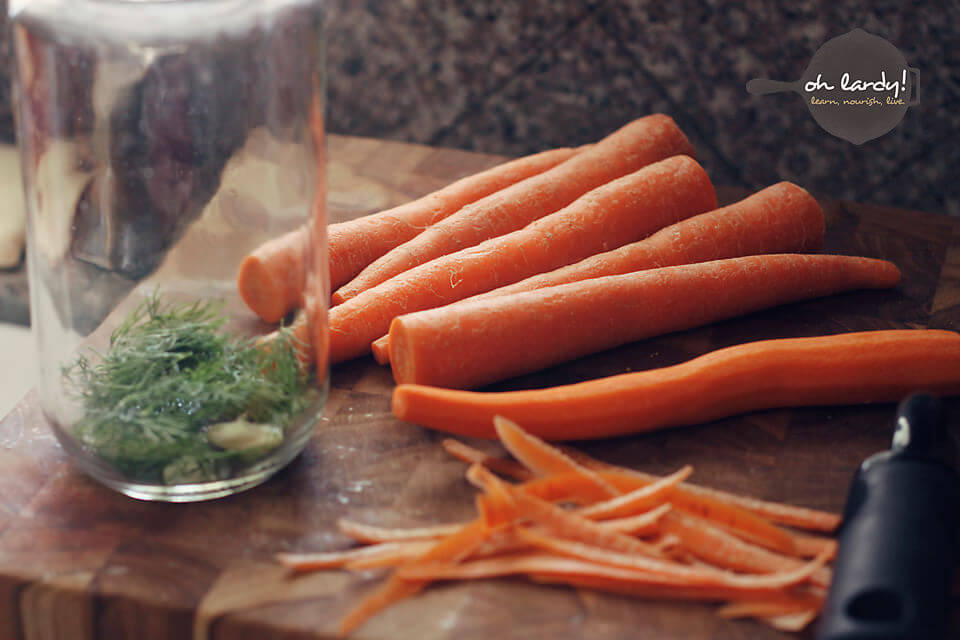
I just love pickled foods. So does my family. Pickles, in particular. My kids would eat an entire jar of pickles if I let them. There is just something magical about the combination of salt, dill, and garlic.
I have lacto-fermented pickles in the past, but wanted to try something different. I have heard of people pickling green beans, but I still wanted the crunch, so I thought fermented carrots might be a good option! I am pretty sure anything can be lacto-fermented (don't quote me on that) so I started looking around. Turns out lots of people make a dilly carrot of some sort. Most of the recipes I found were practically the same, so I decided to just wing it and throw something together. It worked.
First I threw some quartered garlic in a jar along with a bunch of dill. Then, I sliced some carrots into sticks. Anywhere between 5 and 7 carrots will fill a quart size mason jar. I knew I just needed enough to REALLY pack them in there tight.
Once I had my sticks, I packed them in my jar as tight as I could and then added 1 Tablespoon of Sea Salt and 1 Tablespoon of whey.
All that was left to do was to fill the jar with filtered water. Leave some headspace at the top of the jar, an inch or so. Screw on your lid and leave it on your counter and ferment for 4 to 7 days. The warmer your kitchen, the faster the ferment. In fact, mine were ready in 3 days. Taste them after 4 days and if you like them pop them in the fridge to stop the fermentation process and enjoy! You may notice your carrots start to float to the top. This is normal, just make sure they stay submerged in the liquid.
NOTE: If you use a mason jar, you will need to “burp” your jars periodically. I would just check the metal lid from time to time and if I couldn't push it, I knew it was time for a burp. Some people prefer to use a vegetable fermenter of some kind that has an air lock at the top. This eliminates the need to burp your jars. A fermenting crock is on my wish list for sure. No more burping lids AND it has a weight to hold down the veggies.
UPDATE: Tamara informed me that she recently learned that “burping” the jars is unnecessary. Just cover tight with a mason jar lid and leave it be until it is done. She recommended putting the jars on a cookie sheet to catch the liquid that seeps out during fermentation. I will give this method a try next time!
Does the topic of fermenting baffle you? We created a Fermenting eCourse just for you and when you sign up, we will send you a Quick Start Guide! Grab the eCourse and the guide here!
Dilly Carrots
Ingredients
- 5 to 7 carrots peeled and cut into sticks
- 1 tbsp whey
- 1 tbsp sea salt buy here
- 1 tbsp fresh dill or more if you like
- 3 to 4 cloves of garlic quartered
- filtered water
Instructions
- Place your ingredients in a quart sized mason jar and fill within one inch of the top with filtered water.
- Cover and ferment on your counter for 4 to 7 days.
- Refrigerate to stop the fermentation process and enjoy!
Notes
Pin it!
This post participated in Fat Tuesday.

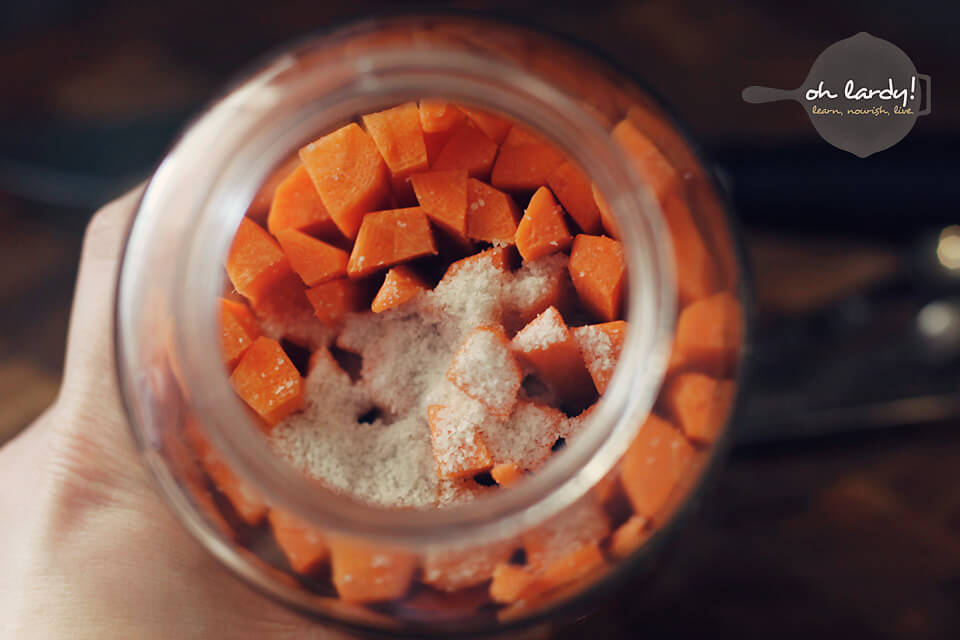
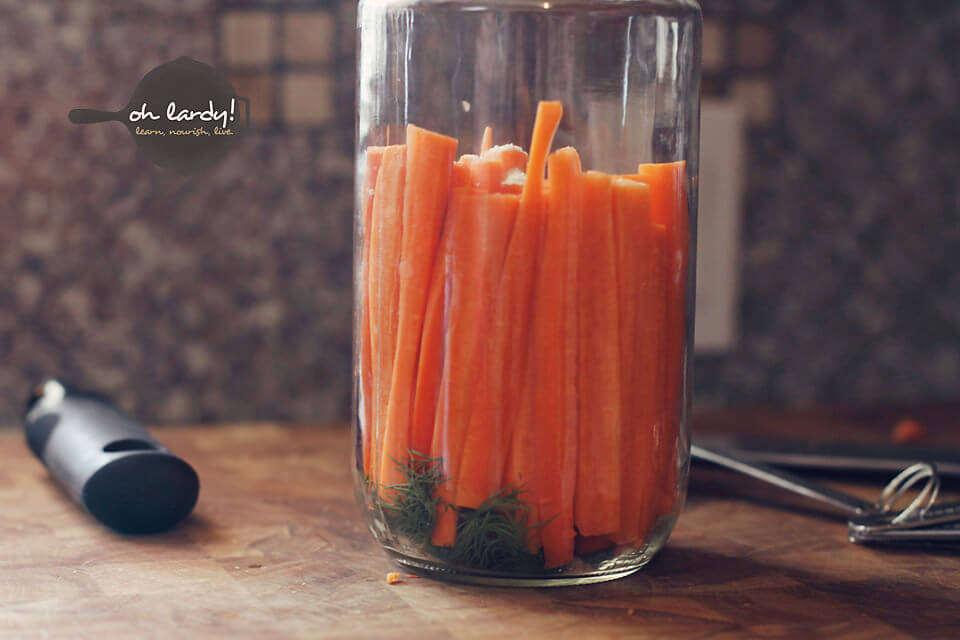
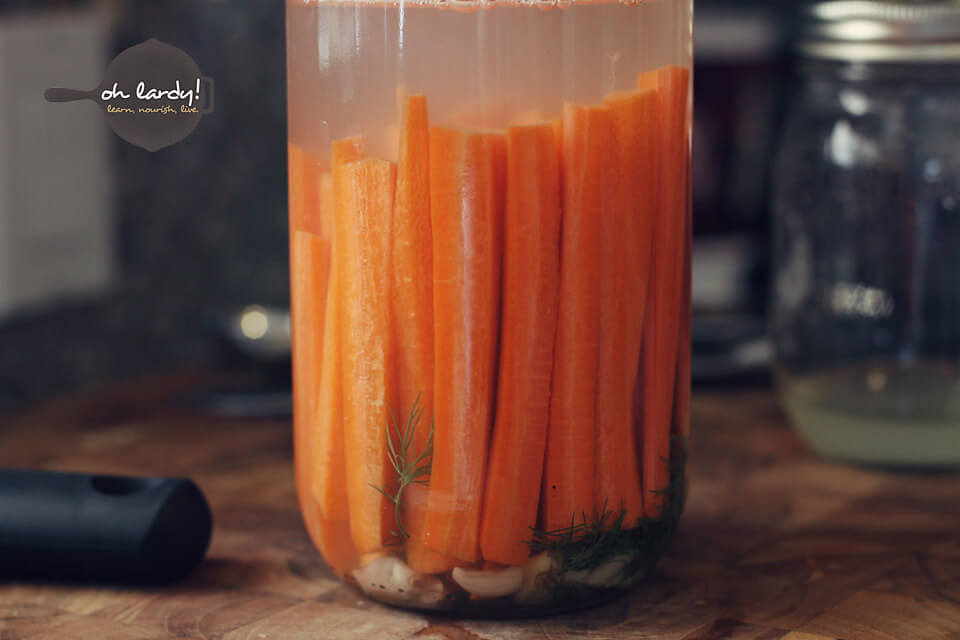
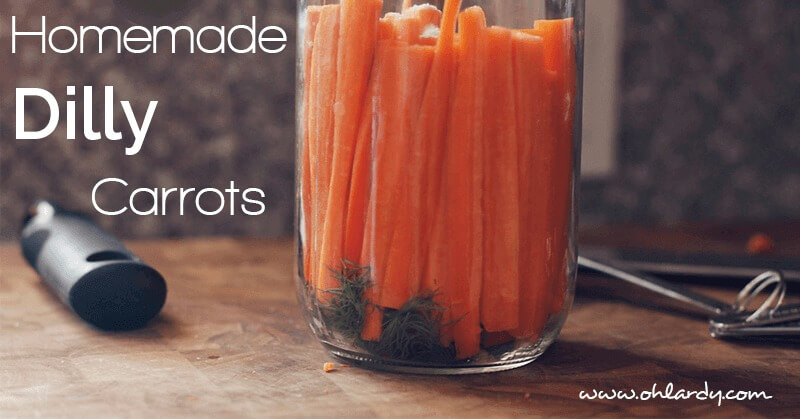
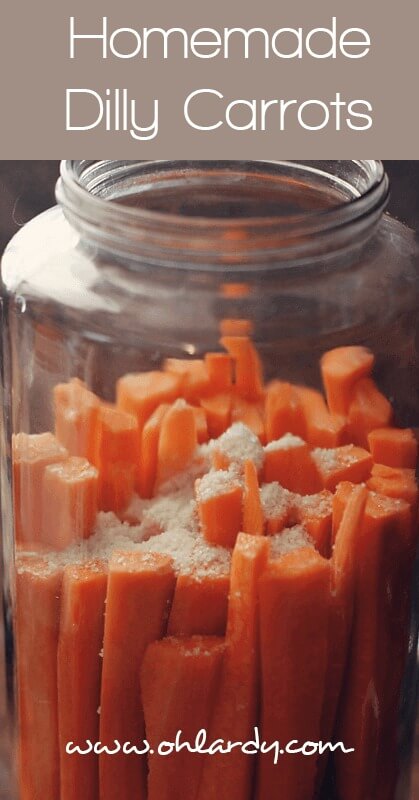
I made some dilly carrots and cucumbers today. Can’t wait to see how they turn out! Thanks for the recipe.
Yay! Hope you enjoy them!!
Just saw your site referenced on FB, the sour cream recipe – just wondering if you have any suggestions for dairy intolerant? I can’t tolerate soy, either (or grains or legumes)
I want to try the Dilly Carrots, but wonder about the Whey?
Thanks so much for your help – your website looks wonderful!
Lynn
There are some non dairy culture starters. I can’t remember which they are though!. Google is your friend for that :). Good luck!!
Is the whey necessary?
No. You can use a powdered culture starter or no starter at all! Up to you! 🙂
Making Dilly green beans today, and am new to this whole fermenting vegetables things. We have always purchased them from Real Pickles, but it is expensive. My question is, after the fermentation process how long are the jars of veggies good for? Is there another way to store them besides in the fridge? I want to stock up so we have jars to last us through winter. Any help would be great!
Fermented foods need to be kept cool in order to stop/slow down fermentation process. A refrigerator at 38 degrees or a root cellar would work. You could buy a small dorm fridge to store your ferments! A vegetable ferment will last 6-12 months in the refrigerator.
We have a Whey allergy, can that step be omitted do you think?
You can skip the whey and add extra salt. Also, http://www.culturesforhealth.com has some culture starters that may be whey free.
I am new at ferments, I have never done it myself but I think I will give these carrots a go. My question is, after you put all the ingredients in the jar do you close it and leave it on the counter? is that all? Thank you and wish me luck at doing these!! 😉
Yep, that is all! Once it is fermented, you transfer to a refrigerator. They will last for at least 6 months, but you will eat them faster than that!!
Good luck and let us know how it turns out!
What makes it ferment? Is it ok if I don’t have whey?
https://ohlardy.com/the-science-and-history-of-culturing-foods
Here is an article that goes more in depth!
I’m wondering if it’s necessary to keep the lids tightly sealed during fermentation. I recently made some dilly brands and kraut with just a salty brine and was instructed to leave the lid loose so the natural yeasts could get to it. Would it be different different because I skipped the whey? They came out great, and this is the next recipe on my list for fermented veggies.
There are a variety of ways to ferment. Sounds like you did a wild ferment. I prefer a controlled ferment. If it worked for you, awesome! Keep doing it!
By brands I mean beans. Silly technology.
I make these, but w/o the whey! They are delicious!
Hi, I have tinkered with fermenting things before. I made kefir and kombucha regularly for years. I have also tried Sauerkraut (I am German, so that was an obvious choice for me). My main problem is always how to keep the vegies submerged. They always float to the top and then I feel a bit scared of eating them. I even went to a fermenting workshop where they showed me how to pack the jars and it still floated to the top after a few days. I’d love to try these carrots. They seem so easy (no massaging for ages as with the kraut). You mention that they float to the top and just to make sure they stay submerged. but how? I also want to try some kimchi. I love spicy foods.
If you have a small jar that will fit inside the carrot jar, pop it inside and fill with water, this has worked for me. My dad has had good luck with a water filled plastic bag on top of his kraut, personally don’t like using plastic. I’ve heard of people using boiled stones or plastic bags full of stones. When I make kraut I fold an outer leaf put it on top then put some of the stalk on top of that so that when the lid is on it presses down on the stalks. Hope this helps Alex!
You can use quite a few things as a ‘weight’. A cabbage leaf works nicely. I use these glass fermentation weights http://amzn.to/1pgPArX. You can also find a nice flat river rock that will fit in your jar, boil it in water to clean and use that!
Hi there, a question about the fermentation process. We’re vegan, will the dilly carrots still turn out without the addition of the whey powder? Thanks, Cailin.
Well, you definitely do not want to use whey powder. It would be liquid whey. But since you are vegan, you wouldn’t use whey liquid either. We recommend Body Ecology Culture Starter. http://bodyecology.com/911-15.html which is considered vegetarian (not vegan, though).
For vegetables, you really don’t need a starter. Just add a bit more salt and go for it! That is called a wild ferement!!! Good luck!
I am new to all of this and wondering where I find whey?
Also, I am really sorry to sound ignorant, but we have city water, so when you say filtered, should I just buy some filtered water from the grocery?
Thanks so much.
We link to a video to get whey in the post! Click ‘whey’ that is highlighted in the post and you will see! Good luck!!
We can’t use whey, could a small amount of kombucha be used as a starter, or would that be weird?
I have never used kombucha as a starter but some people have had success. It is a different combination of bacteria and yeast but you could give it a go. If you are dairy free, using brine from a previous vegetable ferment will work or using the Body Ecology Culture Starter (link located in the right sidebar) can be used as a starter. For vegetables you can do it without a starter as well, just add a little salt 🙂
Hi all,
Just a few thoughts…
1st) I never use whey to ferment vegetables (some vegetable, like beets, that need a little help, I’ll add a little juice from a previous batch of sauerkraut? but in general, use only salt) The bacteria involved in the fermentation of vegetables and is not the same as in yogurt.
Here is a great article on the subject.
http://kitchenlib.com/basics/why-i-dont-use-whey-as-a-vegetable-fermentation-starter/
2nd) Here is a listing on ebay where I buy (lead free) glass weights for holding the veggies down.
http://www.ebay.com/itm/121149550883
3rd) Our favorite fermented carrots are done with jalapenos……..mmm…mmm… good!
I forgot to mention that the glass weights are only $12 plus shipping. You get about 6-7 wide mouth or 9-10 standard. Best deal out there.
NO I’M NOT THE SELLER OR DO I HAVE ANY AFFILIATION!
Thank you for sharing!
These sound wonderful! Have you ever done a fermented bean dip? I’m wondering if I could rinse a can of pinto beans, add water, salt, other herbs and flavoring and a culture starter and let the bacterias do their magic?!? Do you think something like that would work? And then after it is fermented I could blend it all together into a delicious bean dip? Thoughts?
How can I tell if they are properly fermented? I followed recipe and left out for 4 days. They taste good, but no different than regular carrots really. Just garlicy and dilly tasting